
Max 220 pax
Starting from..., sgd 4100 (min 4 hours), perfect for..., average response time, social event | community event | gathering | party, coming soon, wedding | rom | solemnisation, incentive | retreat | corporate d&d, about lazarus ballroom, the bridge is a unique meeting space with a breathtaking 180 degree panoramic view of the sea. this well-lighted space with an enclosed air-conditioned function room and a curved outdoor veranda located on the second floor. perfect space for classes, meetings, team bonding events, retreats, private functions, product launches and even for photo shoot., availability, 09:00 am - 10:00 pm, watch this space, check back regularly for updated venue promotions and grab them.

Lazarus Ballroom
Saf yacht club, sembawang | yishun, resort, banquet halls | dancefloors | exhibition halls | function halls | hotels, get in touch directly with the venue.

is here to help!

Enquiry sent! Our venue partner will get back to you soon!
To mass request for quote, connect and obtain quotes directly from venues. best price guaranteed. no hidden costs, payment or commission., speaker / sound system, whiteboard with markers, air-conditioning, projector / screen / tv, handheld / wireless microphone, nearby carpark, flexibility, in-house catering available, external catering allowed, no cooking activities, vegetarian options available, no pets allowed, halal options available, alcoholic drinks allowed, our clients.

Event Planner Name
Organisation
Lorem Ipsum is simply dummy text of the printing and typesetting industry. Lorem Ipsum has been the industry's standard dummy text ever since the 1500s, when an unknown printer took a galley of type and scrambled it to make a type specimen book.
Terms & Conditions
Reservation deposit amount: 50% event planner shall pay the reservation deposit within 7 day(s) after quote acceptance. event planner shall pay the balance of the booking fee to the venue manager directly during his booking period. no security deposit is required. event planner cancellation policy: if event planner cancels the booking, the venue manager is entitled to forfeit all payments made by the event planner., 43 admiralty rd w, singapore 759962, other spaces under this venue.

Poolside Deck
SAF Yatch Club
Max 100 pax
Poolside Lounge at SAF Yacht Club
About this space.
Located just along the Straits of Johor, take a step out of the hustle and bustle of the CBD area and treat your colleagues or guests to a breathtaking sea view as you unwind and relax to the cool sea breeze. This unique and one of a kind venue is sure to give you a different experience from the usual boring meeting venues. Enquire with us today to learn more!
Event offers and packages
Package per person.
- Corporate Event for 60 guests S$5607.40
- Party for 40 guests S$1722.60
- Kids Birthday Party for 70 guests S$1800
Catering and drinks
Music & sound equipment, accessibility, rules of the space, allowed events.
Pets are not allowed in the club.
Cancellation policy: Custom
Cancellations 14 days in advance from event start time will receive a 50% refund.
Cancellations for events starting within 14 days are non-refundable.
Event date of a confirmed booking can be changed to another date within 6 months from the original date, at no cost.
About SAF Yacht Club
Escape the hustle and bustle of the cityscape and transform your next event to the perfect city getaway. From the cool sea breeze to the breathtaking view, SAF Yacht Club offers an unique experience for any events while keeping it affordable. With the wide selection of menus and customisable options, we will surely be able to craft a perfect fit for your upcoming events. Do enquire with us to find out more!
Other spaces and event packages at this venue
Seminar room, lazarus ballroom, similar spaces.
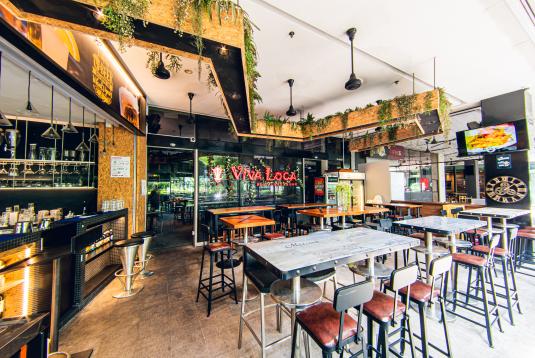
Outdoor Event Space
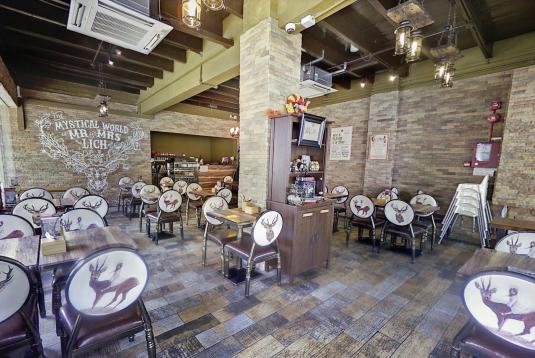
Platform 1094
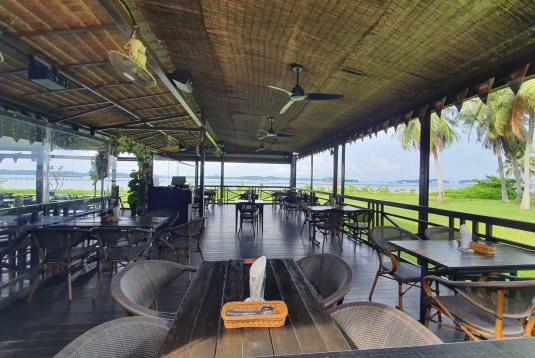
Covered Terrace
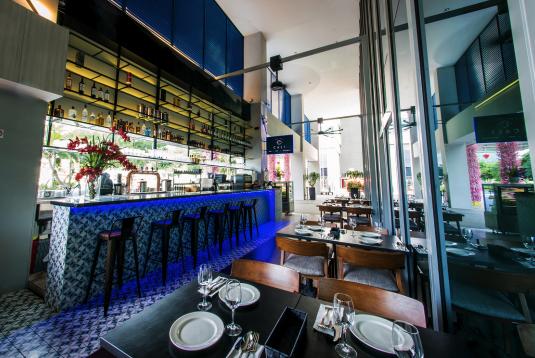
Entire Venue
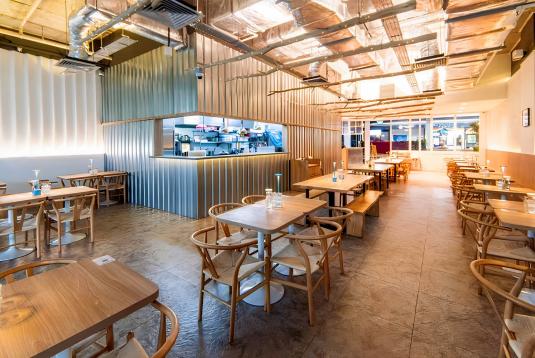
Indoor Dining Area
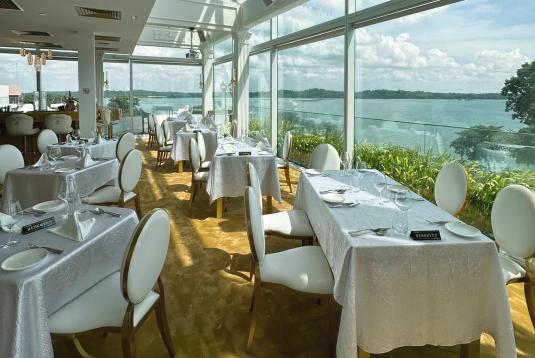
Dining area
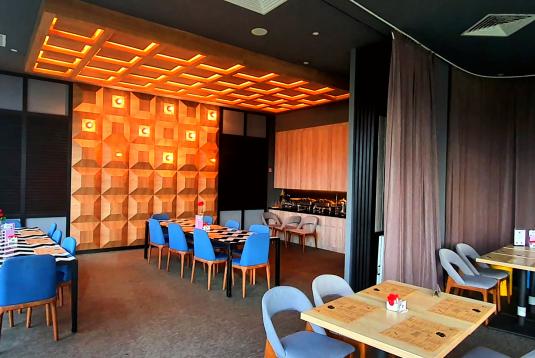
Semi Private
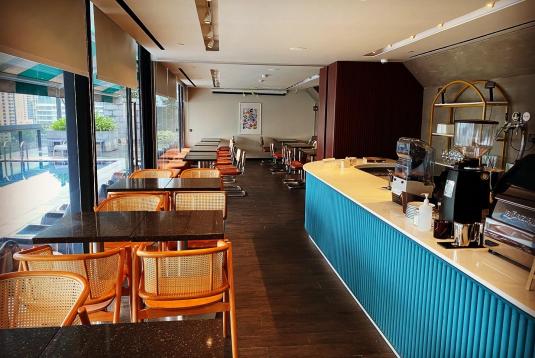
Soll (Sunset On 11)
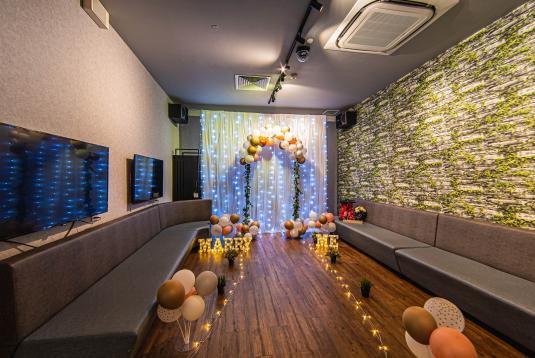
The Backyard

Item added to your cart
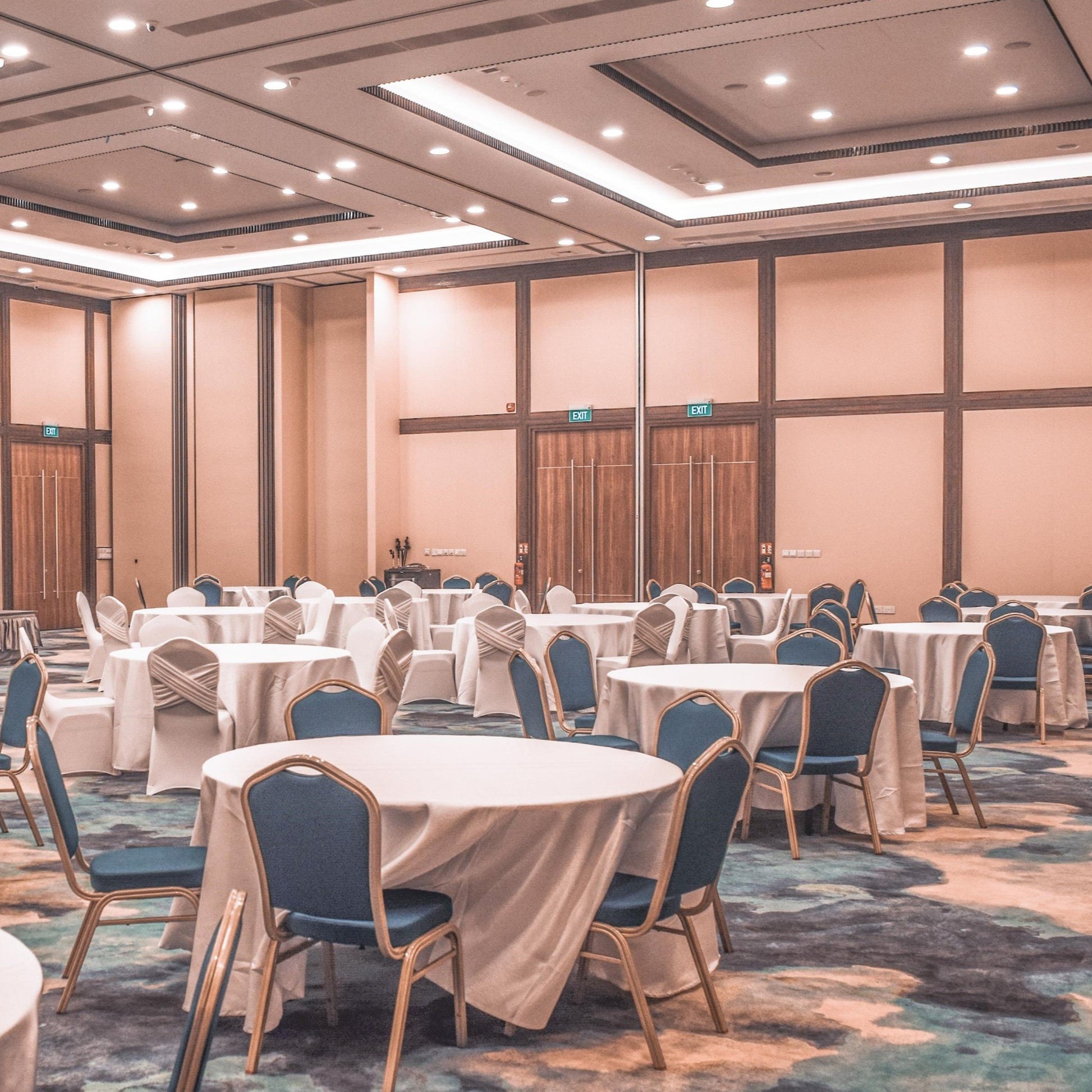
SAF Yacht Club
Good things take time! Do come back another time to check out our Packages.
- Choosing a selection results in a full page refresh.
- Opens in a new window.

- Our Sustainability Journey
- Members’ Privileges
- Reciprocal Arrangement with SAFRA
- Reciprocal Arrangement with SCC, SAF YC and The Chevrons
- Social Amenities
- Sports Amenities
- Club Improvements
- Members’ Activities
- Sports Programme & Classes
- Command Post
- Grand Ballroom
- Portsdown Room
- Seletar Room
- Indoor Solemnisation
- Outdoor Solemnisation
- Virtual Wedding Fair

Reciprocal Arrangement with Sembawang Country Club, SAF Yacht Club and The Chevrons
Temasek Club members can book in person at the Sembawang Country Club, SAF Yacht Club and The Chevrons of their choice by presenting their Temasek Club Virtual Membership Card.
Reciprocal Arrangement with Sembawang Country Club (SCC)
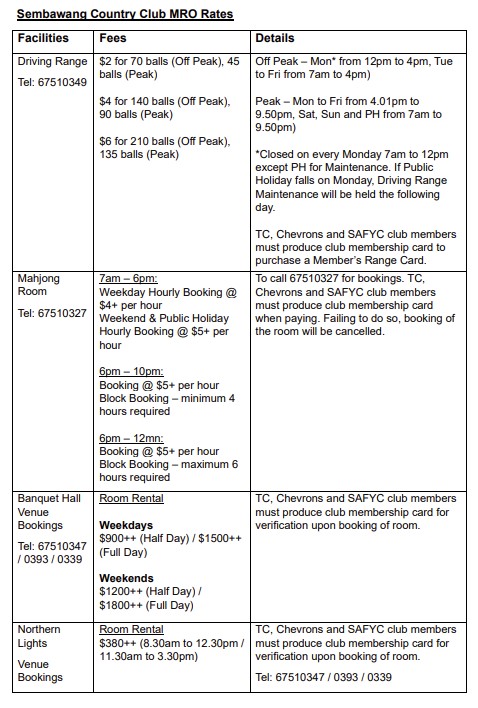
Sembawang Country Club
249 Sembawang Rd, Singapore 758352
Tel: 6751 0320
Website: https://sembawanggolf.org.sg/web/
Reciprocal Arrangement with SAF Yacht Club
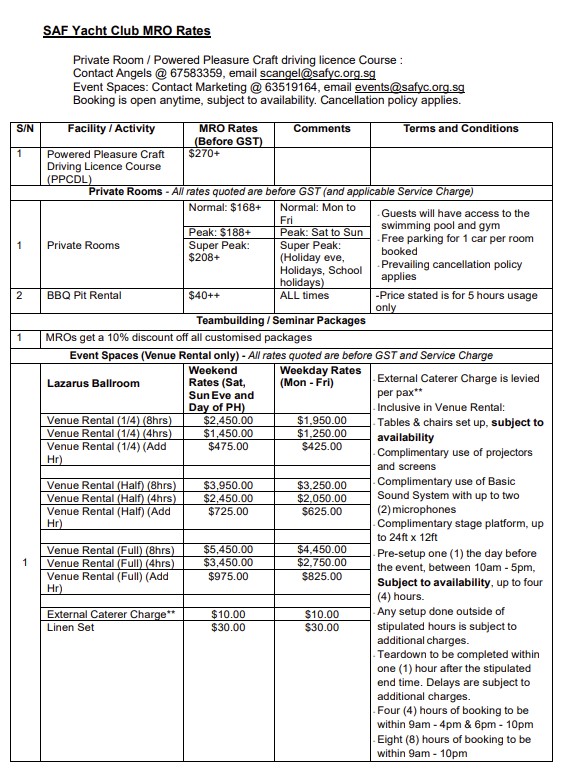
SAF Yacht Club
43 Admiralty Road, Singapore 759962
Tel: 6758 3359
Website: https://www.safyc.org.sg/
Reciprocal Arrangement with The Chevrons
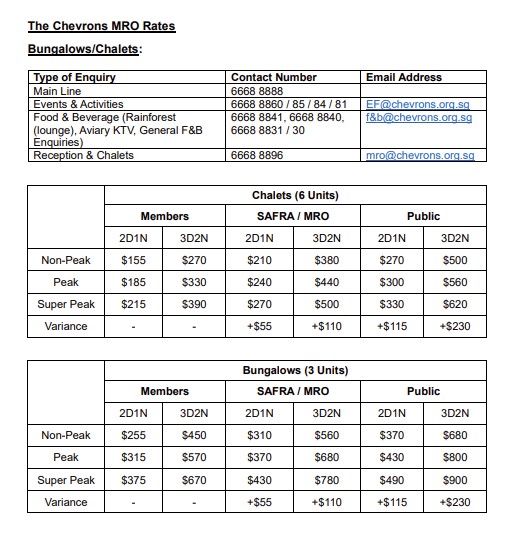
The Chevrons
48 Boon Lay Way, Singapore 609961
Tel: 6668 8888
Website: https://www.chevrons.org.sg/
131 Rifle Range Road,
Singapore 588406
T: 6801 4242
By continuing to browse this website, you are consenting to our Privacy Policy and the use of Cookie Policy. Learn More >>
131 Rifle Range Road, Singapore 588406
By continuing to browse this website, you are consenting to our Privacy Policy and the use of Cookie Policy.
Learn More >>
For announcements, view here .

Yacht Club Ballrooms
Complete details on these venues, including pricing and capacity, may be found in Carrie Hayward’s Fairytale Weddings Guide .
- Asbury C & D
- Asbury A & B
- Asbury Patio
- Asbury Rotunda
- Cape Cod Hall
- Eastham Lobby
- Grand Harbor Ballroom
- Hampton Room
- Newport Ballroom
- Saybrook Room
- Wellfleet Lobby

© Ashlyn Cathey Photography

© Captured By Elle

New Carpet © Disney

© Root Photography

© Carrie Hayward

© Kat T Imundi

(Previous décor scheme)

The Hampton Room is identical to the Saybrook Room. Click the Saybrook Room tab to see its current decor.

This is the current décor scheme for all Yacht Club Convention Center rooms.

Newport Lobby

© White Rabbit Photo Boutique

West Rotunda

2 thoughts on “ Yacht Club Ballrooms ”
I saw that this wasn’t a ballroom room listed in your guide, do they still allow receptions here? Thank you!
Yacht & Beach Club Convention Center info is on page 72 of the guide!
Leave a Reply Cancel reply
Your email address will not be published. Required fields are marked *
Notify me of new posts by email.
This site uses Akismet to reduce spam. Learn how your comment data is processed .
- Breaking News
- Your Community
- Florida News
- National News
- Election 2022
- Local Sports
- Sports Columns
- Florida Sports
- National Sports
- Letters To The Editor
- Local Columns
- Local Lifestyles
- Clubs & Organizations
- Engagements
- Cape Coral Business Directory
- Cape Coral’s 50th Anniversary
- Cape Coral’s 40th Anniversary
- Cape Coral’s 45th Anniversary
- Hurricane Guide
- Best of Cape Winners Magazine
- Best of Cape Winners Website
- Submit News
- Statement of Values
- Terms of Service
- Classifieds
- Single Copy Locations
- Browse notices
- Place a notice

Yacht Club ballroom razed
By staff | apr 24, 2024.

The historic Yacht Club ballroom undergoes the wrecking claw today as demolition at the city park continues. The building is expected to be demolished by week’s end. PROVIDED BY THE CITY OF CAPE CORAL

Charlotte County priest arrested for capital sexual battery from time in Iowa

Quarter Auction to benefit Cape Museum of History
- All Moscow Hotels
- Most Popular
- Hotels by Class
- Quick Search
- Request Best Rates
- Recommended Hotels
- Event Planning Tips
- Moscow Meeting Space
- Request a Proposal
- Group Travel Info
- Russian Visa Info
- Request Visa Support
- Airport Transfers
- Airline & Rail Tickets
- St. Petersburg Hotels
Ritz-Carlton Hotel
- Meeting Facilities
Conference Halls
- CONFERENCE HALLS
- MEETING ROOMS
The Ritz-Carlton Moscow Hotel's large MICE venues are as sumptuously fitted as the hotel's other public spaces, combining classical opulence with state-of-the-art technical capabilities to provide unique and prestigious venues for major business meetings or banquets and celebrations.
Take a look at what architects pitch for a redesigned Cape Coral Yacht Club

New details, photos, and a video have emerged on the proposed changes to the Cape Coral Yacht Club Community Park, changing it from an Old Florida feel to a 'Key West' vibe.
The city plans to present these updates on the Yacht Club at this week's committee of the whole meeting at 9 a.m. Wednesday in council chambers at 1015 Cultural Park Blvd.
Here's what we know.
Yacht Club changes explained
Cape Coral's Yacht Club Community Park , which includes a yacht basin, tennis courts, a swimming pool, a ballroom, and a beach, has served as a popular attraction and staple for the city since the 1960s, built and open just a few years after the city's inception in 1957 by brothers Jack and Leonard Rosen .
In 2018, voters approved a $60 million expansion of the city's parks and amenities through the Parks and Recreation General Obligation (GO) Bond. Part of that was intended for the Yacht Club.
The Cape Coral City Council originally planned to close and begin work on renovations for the park in 2021 .
But then Hurricane Ian struck the city on Sept. 28, 2022, delaying the project with the council eventually opting to revamp the whole area, with the city pointing toward the high cost of repairs and being over FEMA's 50% rule as justification for moving forward with new buildings and amenities.
Longtime residents and former city officials opposed the plans - however, they could not sway the council to change its mind on the new plans.
What's featured in the new Yacht Club?
The current plans include a new two-story community center to replace the ballroom, removing the tennis courts, rearranging the area to accommodate a four-story parking garage, a new restaurant, and a new 14,500-square-foot resort-style pool.
Current parking at the park; including for boats, vehicles, and boat trailers, amounts to 551 total spaces.
The proposed changes would bring a four-story garage with approximately 685 parking spaces, 15 surface spaces at the main building, 46 boat trailers, and 158 boat slip spaces - totaling 904 parking spaces.
The new two-story community center would have 47,000 square feet and include a new ballroom, concession, history room, exterior balcony, storage and meeting space, and a multi-purpose hall.
Previous discussions estimate the cost of the project to be as much as $100 million .
Demolition has begun
Cape Coral has already begun the work toward these changes as demolition started this month.
The city will demolish the main buildings and attached amenities of the Yacht Club, including the ballroom building, the Tony Rotino Center, tennis courts, pool, and harbormaster.
Johnson-Laux Construction, a full-service construction management firm that operates out of Winter Garden, has been contracted to demolish and deconstruct the Yacht Club for $987,716.04.
The firm is also tasked with preserving a portion of the old ballroom building, which includes interior ceiling beams, stonework, a fountain, and interior doors.
Construction will not affect the beach area.
What's next? When's the completion?
A public meeting to review and showcase current Yacht Club designs will be held on May 7.
The city is still in the design phase and has no estimated timeframe for completion.
Luis Zambrano is a Watchdog/Cape Coral reporter for The News-Press and the Naples Daily News. You can reach Luis at [email protected]. Follow him on Twitter @Lz2official .
Three decades after the Soviet era, this Moscow street echoes what was.
And hints where russia is heading., welcome to tverskaya street.
MOSCOW — Thirty years ago, the Soviet Union ceased to be. The flag was lowered for the last time on Dec. 25, 1991. That moment still raises deep questions for the U.S.S.R.’s heirs: “Who were we as Soviets, and where are we going as Russians?”
Many of the answers can be found on Moscow’s main thoroughfare — named Gorky Street, after writer Maxim Gorky, from 1932 to 1990, and renamed Tverskaya Street, a nod to the ancient city of Tver, as the Soviet Union was awash in last-gasp reforms.
It was the Soviet Union’s display window on the bright future that Kremlin-run communism was supposed to bring. It was where the KGB dined, the rich spent their rubles, Vladimir Lenin gave speeches from a balcony, and authorities wielded their power against one of the most famous Soviet dissidents, Alexander Solzhenitsyn.

In the 1990s, Tverskaya embodied the fast-money excesses of the post-Soviet free-for-all. In later years, it was packed with hopeful pro-democracy marchers. And now , under President Vladimir Putin, it is a symbol of his dreams of reviving Russia as a great power, reliving past glories and crushing any opposition to his rule.
Join a tour of Moscow’s famed Tverskaya Street.
Hotel National: Where the Soviet government began
The window in Room 107 at the Hotel National faces Red Square and the Kremlin. It offers a perfect view of Lenin’s tomb — fitting, since he was Room 107’s most famous guest.
The Kremlin was damaged during the Russian Revolution in 1917. So Lenin and his wife moved into Room 107 for seven days in March 1918, making the hotel the first home of the Soviet government.

The Hotel National in Moscow, from top: Artwork in the Socialist Realist style — which artists were ordered to adopt in the 1930s — still adorns the hotel; Elena Pozolotina has worked at the hotel since 1995; the hotel, which contains a restaurant, was built in 1902; the National has hosted notable guests, including Soviet leader Vladimir Lenin, then-Sen. Barack Obama (D-Ill.) and actor Jack Nicholson. (Photos by Arthur Bondar for The Washington Post)
The National, built in 1902 during the era of Imperial Russia, also accommodated other Soviet leaders, including Leon Trotsky and Felix Dzerzhinsky, chief of the secret police. The building continued to be used by the Soviet government as a hostel for official party delegates and was renamed First House of Soviets in 1919.
Guests can now stay in the same room Lenin did for about $1,300 a night. In more recent years, the hotel has hosted notable guests including Barack Obama (when he was a senator) and actor Jack Nicholson.
“This hotel feels a little like a museum,” said Elena Pozolotina, who has worked at the National since 1995.
“We have rooms that look onto Tverskaya Street, and we always explain to guests that this is the main street of our city,” Pozolotina said. “This corner of Tverskaya that we occupy, it’s priceless.”

Stalin’s plan: ‘The building is moving’
When Soviet leader Joseph Stalin demanded a massive redevelopment of Moscow in 1935, an order came to transform modest Gorky Street into a wide, awe-inspiring boulevard.
Engineer Emmanuel Gendel had the job of moving massive buildings to make way for others. Churches and monasteries were blown up, replaced by newspaper offices and a huge cinema.
The Moscow Central Eye Hospital was sheared from its foundation, rotated 97 degrees, jacked up, hitched on rails and pushed back 20 yards — with surgeons operating all the while, or so official media reported at the time.

Gendel’s daughter, then about 8, proudly stood at a microphone, announcing: “Attention, attention, the building is moving.” Tatiana Yastrzhembskaya, Gendel’s granddaughter and president of the Winter Ball charity foundation in Moscow, recalls that Gendel extolled communism but also enjoyed the rewards of the elite. He drove a fine car and always brought the family the best cakes and candies, she said.
The largest Gorky Street building Gendel moved was the Savvinskoye Courtyard. The most difficult was the Mossoviet, or Moscow city hall, with a balcony where Lenin had given speeches. The building, the former residence of the Moscow governor general, had to be moved with its basement. The ground floor had been a ballroom without central structural supports.

Moving buildings on Gorky Street in 1940, from left: A mechanic at a control panel regulates the supply of electricity while a house is being moved; a postal worker passes a moving house; a specialist unwinds a telephone cable during a building move to maintain uninterrupted communication; 13 rail tracks were placed under a house, on which 1,200 metal rollers were laid. (Photos by RGAKFD)
Gendel’s skills were used all over the U.S.S.R. — straightening towers on ancient mosques in Uzbekistan, inventing a means to drag tanks from rivers during World War II and consulting on the Moscow Metro.
Like many of the Soviet Union’s brightest talents, Gendel found that his freedom was tenuous. His ex-wife was called by the KGB internal spy agency in 1937 and asked to denounce him. She refused, and he avoided arrest.

“I believe he was not arrested and sent to the camps because he was a unique expert,” said Yastrzhembskaya. World War II, known in Russia as the Great Patriotic War, interrupted the Master Plan for Gorky Street.
Aragvi restaurant: A haunt of the KGB
In the 1930s, the head of the elite NKVD secret police, Lavrenty Beria, one of the architects of the Stalin-era purges, ordered the construction of a state-owned restaurant, Aragvi, to showcase food from his home republic of Georgia.
One night, NKVD agents descended in several black cars on a humble Georgian canteen in Moscow that Beria had once visited. The agents ordered the chef, Longinoz Stazhadze, to come with them. The feared NKVD was a precursor to the KGB.
Stazhadze thought he was being arrested, his son Levan told Russian media. He was taken to Beria, who said that he had agreed with “the Boss” (Stalin) that Stazhadze would run Aragvi. Stazhadze had grown up a peasant, sent to work in a prince’s kitchens as a boy.

Aragvi opened in 1938. It was only for the gilded set, a reminder that the “Soviet paradise” was anything but equitable. The prices were astronomical. It was impossible to get a table unless the doorman knew you or you could pay a hefty bribe.
Aragvi, at No. 6 Tverskaya, was a favorite of the secret police; government officials; cosmonauts and pilots; stars of theater, movies and ballet; directors; poets; chess masters. Beria reputedly dined in a private room. Poet Sergei Mikhalkov said he composed the lyrics of the Soviet national anthem while sitting in the restaurant in 1943.
It was privatized in the 1990s and struggled, before closing in 2002. It reopened in 2016 after a $20 million renovation. But the new Aragvi closed abruptly in 2019 amid reports of a conflict between its owner and the building managers.
“You put your entire soul into cooking,” said the former head chef, Nugzar Nebieridze, 59, celebrated for his khinkali, a meaty dumpling almost the size of a tennis ball. He was devastated to find himself unemployed. But other doors opened. He now prefers to travel, giving master classes around Russia.
Stalin’s funeral: A deadly street crush that never officially happened
On March 6, 1953, the day after Stalin died of a stroke, an estimated 2 million Muscovites poured onto the streets. They hoped to catch a glimpse of his body, covered with flowers and laid out in the marbled Hall of Columns near Red Square.
Yulia Revazova, then 13, sneaked from her house with her cousin Valery without telling their parents. As they walked toward Pushkin Square, at one end of Gorky Street, the procession turned into a scene of horror. They saw people falling and being trampled. Some were crushed against metal fences. Valery, who was a few years older, grabbed Yulia by the hand and dragged her out of the crowd.

“He held my hand really tight and never let it go, because it was pure madness,” she recalled recently. “It took us four or five hours to get out of there. People kept coming and coming. I couldn’t even call it a column; it was just an uncontrollable mass of people.”
“I still have this feeling, the fear of massive crowds,” added Revazova, 82. “To this day, if I see a huge group of people or a really long line, I just cross the street.”
Neither Revazova nor her cousin knew about Stalin’s repressions.
“People were crying. I saw many women holding little handkerchiefs, wiping away tears and wailing,” she recalled. “That’s the psychology of a Soviet person. If there is no overarching figure above, be it God or Lenin, life will come crashing down. The era was over, and there was fear. What will we do without Stalin?”
Officials never revealed how many people died that day. The Soviet-approved archival footage of the four days of national mourning showed only orderly marches and memorials.
No. 9: The ruthless culture minister
The Soviet culture minister, the steely Yekaterina Furtseva, was nicknamed Catherine the Third, after the forceful Russian Empress Catherine the Great. Furtseva destroyed writers, artists or anyone else who challenged Soviet ideas. She lived at an elite 1949 apartment building for government officials at No. 9 — an ultra-prestigious address with a view of the Kremlin.
Furtseva, a former small-town weaver, made sure that No. 9 was only for the cream of party officials and other notables, such as famous Soviet actress Natalia Seleznyova, scientists, conductors and architects.
Riding the coattails of Soviet leader Nikita Khrushchev, Furtseva was the only woman in the Politburo and later became the Soviet Union’s cultural gatekeeper despite her provincial sensibilities. She once infamously mixed up a symphony with an opera, and critics were quick to notice.

“She had little in common with the artistic leaders of her country except a liking for vodka,” Norwegian painter Victor Sparre wrote in his 1979 book on the repression of dissident Soviet writers, “The Flame in the Darkness.”
Furtseva was famous for previewing performances and declaring anyone even subtly critical of Soviet policies as being anti-state. Director Yuri Lyubimov described one such visit to Moscow’s Taganka Theater in 1969, when she turned up wearing diamond rings and an astrakhan coat. She banned the play “Alive,” depicting a cunning peasant’s struggle against the collective farm system. She “was livid, she kept shouting,” he told L’Alternative magazine in 1984. She stormed out, warning him she would use her influence, “up to the highest levels,” against him.
He was expelled from the party and in 1984 was stripped of his citizenship. She vehemently denounced Solzhenitsyn, and banned the Bolshoi Ballet’s version of “Carmen” in 1967 over prima ballerina Maya Plisetskaya’s sensual performance and “un-Soviet” costumes that did not cover enough leg.
“The ballet is all erotica,” she told the dancer. “It’s alien to us.” But Plisetskaya, whom Khrushchev once called the world’s best dancer, fought back. The ballet went on with some excisions (the costumes stayed) and became a legend in the theater’s repertoire.
Furtseva was nearly felled by scandal in 1974, ordered to repay $80,000 spent building a luxurious dacha, or country home, using state labor. She died months later.

Where Solzhenitsyn was arrested
The Nobel Prize-winning Solzhenitsyn exposed the Soviet system’s cruelty against some of its brightest minds, trapped in the gulag, or prison camps.
Solzhenitsyn was given eight years of hard labor in 1945 for privately criticizing Stalin, then three years of exile in Kazakhstan, a Soviet republic at the time. His books were banned. After release from exile in 1956, he was allowed to make only 72-hour visits to the home of his second wife, Natalia, at 12 Gorky St., Apt. 169. Solzhenitsyn had to live outside the city.
“People knew that there were camps, but not many people, if any, knew what life was like in those camps. And he described it from the inside. He had been there himself, and that was shocking to a lot of people,” said Natalia Solzhenitsyna during a recent interview at the apartment, which became a museum in 2018.
“Many people say that he did make a contribution to the final fall of the Soviet Union.”
Solzhenitsyn, who died in 2008, called Russia “the land of smothered opportunities.” He wrote that it is always possible to live with integrity. Lies and evil might flourish — “but not through me.”
The museum displays tiny handwritten copies of Solzhenitsyn’s books, circulated secretly; film negatives of letters smuggled to the West; and beads made of compacted bread that he used to memorize poems in prison.
“He spent a lot of time here with his children. We were always very busy. And we just enjoyed ourselves — being together,” Solzhenitsyna said. They had three sons.

No. 12 Gorky St., from top: Natalia Solzhenitsyna lived in the apartment for years, and her husband, Soviet dissident Alexander Solzhenitsyn, was allowed only short visits; the site now houses a museum displaying items connected to him, such as negatives containing a copy of a novel he wrote; another exhibit includes Solzhenitsyn’s clothes from when he was sent to the gulag and beads made of compacted bread that he used to memorize poems; the Nobel Prize-winning writer’s desk is featured at the museum. (Photos by Arthur Bondar for The Washington Post)
Because of KGB bugs, if the couple were discussing something sensitive, they wrote notes to each other, and then destroyed them. Two KGB agents usually roosted in the stairwell on the floor above, with two more on the floor below.
“The Soviet authorities were afraid of him because of his popularity among intellectuals, writers, people of culture and the intelligentsia.”
Her favorite room is decked with black-and-white photos of dissidents sent to the gulag, the Soviet Union’s sprawling system of forced labor camps. “It’s dedicated to the invisibles,” she said, pointing out friends.
Sweden planned to award Solzhenitsyn’s 1970 literature prize in the Gorky Street apartment, but the writer rejected a secret ceremony. A Swedish journalist in Moscow, Stig Fredrikson, was Solzhenitsyn’s smuggler. He carried Solzhenitsyn’s Nobel lecture on tightly rolled film disguised as a battery in a transistor radio, and he took other letters to the West and transported photos taped to his back.
“I felt that there was a sense of unfairness that he was so isolated and so persecuted,” Fredrikson said in a recent interview. “I got more and more scared and more and more afraid every time I met him.”
In 1971, the Soviet Union allegedly tried to poison Solzhenitsyn using a secret nerve agent, leaving him seriously ill. Early 1974 was tense. The prosecutor subpoenaed him. State newspapers railed against him.
The morning of Feb. 12, 1974, the couple worked in their study. In the afternoon, he walked his 5-month-old son, Stepan, in the yard below.
“He came back here, and literally a minute later, there was a ring at the door. There were eight men. They immediately broke the chain and got in,” his widow said. “There was a prosecutor in his prosecutor’s uniform, two men in plainclothes, and the rest were in military uniform. They told him to get dressed.”
“We hugged and we kept hugging for quite a while,” she recalled. “The last thing he told me was to take care of the children.”
He was deported to West Germany. The couple later settled in Vermont and set up a fund to help dissident writers, using royalties from his book “The Gulag Archipelago.” About 1,000 people still receive money from the fund, according to Solzhenitsyna.
When the writer and his wife returned to Russia in 1994, they traveled across the country by train. Thousands of people crushed into halls to hear him speak.
Solzhenitsyn abhorred the shock therapy and unchecked capitalism of the 1990s and preferred Putin’s tough nationalism. He died of heart failure at 89 in August 2008, five months after a presidential election in which Putin switched places with the prime minister, Dmitry Medvedev, in a move that critics saw as a ploy to get around constitutional term limits.
No. 6: ‘Feasts of thought’
Behind a grand Stalin-era apartment block at 6 Gorky St. sits an ornate 1907 building famous for its facade, art nouveau glazed blue tiles, elegant arches and baroque spires. Once a monastery dormitory, it was a staple of pre-Soviet postcards from Moscow. But in November 1939, the 26,000-ton building was put on rails and pushed back to widen the street.
Linguists Lev and Raisa Kopelev lived in Apt. 201 on the top floor. Their spacious dining room became a favored haven for Moscow’s intelligentsia from the 1950s to the 1980s.

“People gathered all the time — to talk. In this apartment, like many other kitchens and dining rooms, at tables filled more often than not with vodka, herring and vinaigrette salad, feasts of thought took place,” said Svetlana Ivanova, Raisa’s daughter from another marriage, who lived in the apartment for nearly four decades.
Solzhenitsyn and fellow dissident Joseph Brodsky were Kopelev family friends, as were many other artists, poets, writers and scientists who formed the backbone of the Soviet human rights movement of the 1960s.
As a writer and dissident, Kopelev had turned his back on the Communist Party and a prestigious university position. The onetime gulag prisoner inspired the character Lev Rubin in Solzhenitsyn’s novel “In the First Circle,” depicting the fate of arrested scientists.
“The apartment was a special place for everyone. People there were not afraid to speak their mind on topics that would be considered otherwise risky,” Ivanova said. “A new, different spirit ruled in its walls.”
Eliseevsky: Pineapples during a famine
The Eliseevsky store at No. 16 was a landmark for 120 years — born in czarist Russia, a witness to the rise and fall of the Soviet Union, a survivor of wars, and a bastion during eras of shortages and plenty. It closed its doors in April.
Eliseevsky fell on hard times during the coronavirus pandemic, as international tourists dwindled and Russians sought cheaper grocery-shopping alternatives.
In the palace-like interior, two chandeliers hang from an ornate ceiling. Gilt columns line the walls. The front of the store, looking out at Tverskaya Street, has a row of stained glass.

The Eliseevsky store, which opened in 1901, is seen in April, with a few customers and some archival photos, as it prepared to close as an economic victim of the coronavirus pandemic. (Photos by Arthur Bondar for The Washington Post)
Denis Romodin, a historian at the Museum of Moscow, said Eliseevsky is one of only two retail spaces in Moscow with such pre-revolutionary interiors. But Eliseevsky’s level of preservation made it “one of a kind,” he said.
The building was once owned by Zinaida Volkonskaya, a princess and Russian cultural figure in the 19th century. She remodeled the house into a literary salon whose luminaries included Russia’s greatest poet, Alexander Pushkin.
St. Petersburg merchant Grigory Eliseev opened the market in 1901. It quickly became a hit among Russian nobility for its selection of European wines and cheeses.

Romodin said it was Russia’s first store with price tags. Before Eliseevsky, haggling was the norm. And it was also unique in having innovative technology for the time: electric-powered refrigerators and display cases that allowed goods to be stored longer.
Even in the Soviet Union’s hungriest years, the 1930s famine, Eliseevsky stocked pineapples.
“One could find outlandish delicacies here, which at that time seemed very exotic,” Romodin said. “It was already impossible to surprise Muscovites with wine shops. But a grocery store with luxurious interiors, and large for that time, amazed and delighted Muscovites.”

The First Gallery: A glimpse of openness
In 1989, in a dusty government office by a corner of Pushkin Square, three young artists threw off decades of suffocating state control and opened the Soviet Union’s first independent art gallery.
That April, Yevgeny Mitta and two fellow students, Aidan Salakhova and Alexander Yakut, opened First Gallery. At the time, the Soviet Union was opening up under policies including glasnost, which gave more room for public debate and criticism.
Artists were ordered to adopt the Socialist Realist style in 1934, depicting scenes such as happy collective farmworkers. Expressionist, abstract and avant-garde art was banned. From the 1970s, underground art exhibitions were the only outlets to break the Soviet-imposed rules.

The First Gallery, from top: Yevgeny Mitta, Aidan Salakhova and Alexander Yakut opened the Soviet Union’s first independent art gallery in 1989 and received media attention; Mitta works on a painting that he displayed at his gallery; Mitta recalled recently that he “felt we had to make something new”; an undated photo of Mitta at his gallery in Soviet times. (Photos by Arthur Bondar for The Washington Post and courtesy of Yevgeny Mitta)
“I just felt we had to make something new,” recalled Mitta, 58, who kept his interest in contemporary expressionism a secret at a top Moscow art school in the 1980s.
“It was like nothing really happened in art history in the 20th century, like it stopped,” he said. “The Socialist Realism doctrine was invented and spread to the artists as the only one, possible way of developing paintings, films and literature.”
After the collapse of the Soviet Union, artists had to “learn how to survive, what to do, how to work and make a living,” he said.
McDonald’s: ‘We were not used to smiling’
In the Soviet Union’s final years, a mania raged for all things Western. Estée Lauder opened the first Western-brand shop on Gorky Street in 1989, after meeting Raisa Gorbachev, the wife of reformist Soviet leader Mikhail Gorbachev, in December 1988.
The Soviet Union’s first McDonald’s, located across Pushkin Square on Gorky Street, opened on Jan. 31, 1990 — a yellow-arched symbol of Gorbachev’s perestroika economic reforms. Pizza Hut opened later that year. (In 1998, Gorbachev starred in a commercial for the pizza chain.)
Karina Pogosova and Anna Patrunina were cashiers at the McDonald’s on opening day. The line stretched several blocks. Police officers stood watch to keep it organized.

The Soviet Union’s first McDonald’s opened in 1990 and eager customers lined up to enter; Karina Pogosova, left, and Anna Patrunina were cashiers at the fast-food restaurant on Gorky Street then, and they are senior executives with the company today. (Photos by Peter Turnley/Corbis/VCG/Getty Images and Arthur Bondar for The Washington Post)
“The atmosphere was wonderful. The first day I had to smile the entire day and my face muscles hurt,” Patrunina said. “This is not a joke. Russians do not smile in general, so we were not used to smiling at all, not to mention for more than eight hours straight.”
Pogosova and Patrunina were students at the Moscow Aviation Institute when they learned McDonald’s was hiring through an ad in a Moscow newspaper. Interview questions included: “How fast can you run 100 meters?” It was to gauge if someone was energetic enough for the job.
Pogosova and Patrunina are still with the company today, as senior vice president of development and franchising and vice president of operations, respectively.
“I thought that this is the world of opportunities and this new world is coming to our country, so I must be in this new world,” Patrunina said.
The smiling staff wasn’t the only culture shock for customers. Some had never tried the fountain sodas that were available. They were unaccustomed to food that wasn’t eaten with utensils. The colorful paper boxes that Big Macs came in were occasionally saved as souvenirs.
McDonald’s quickly became a landmark on the street.
“I remember very well that the street and the entire city was very dark and McDonald’s was like an island of light with bright signage,” Pogosova said. “The street started to change after McDonald’s opened its first restaurant there.”
Wild ’90s and a missing ballerina
The end of the Soviet Union uncorked Moscow’s wild 1990s. Some people made instant fortunes by acquiring state-owned enterprises at throwaway prices. Rules were being written on the fly. The city was pulsing with possibilities for those with money or those desperate to get some.
“It was easy to get drunk on this,” said Alex Shifrin, a former Saatchi & Saatchi advertising executive from Canada who lived in Moscow from the mid-1990s until the late 2000s.
It all was on full display at Night Flight, Moscow’s first nightclub, opened by Swedish managers in 1991, in the final months of the Soviet Union, at Tverskaya 17. The club introduced Moscow’s nouveau elite to “face control” — who merits getting past the rope line — and music-throbbing decadence.
The phrase “standing on Tverskaya” made its way into Russian vernacular as the street became a hot spot for prostitutes. Toward the end of the 2000s, Night Flight had lost its luster. The club scene in Moscow had moved on to bigger and bolder venues.
Decades before, No. 17 had been famous as the building with the dancer: a statue of a ballerina, holding a hammer and sickle, placed atop the cupola during Stalin’s building blitz.

Muscovites nicknamed the building the House Under the Skirt.
“The idea was to have Gorky Street as a museum of Soviet art. The statues represented a dance of socialism,” art historian Pavel Gnilorybov said. “The ballerina was a symbol of the freedom of women and the idea that, before the revolution, women were slaves. It is as if she is singing an ode to the regime.”
The crumbling statues were removed by 1958. People forgot them. Now a group of Muscovites, including Gnilorybov, are campaigning for the return of the ballerina.
“It’s an idea that we want to give the city as a gift. It’s not political,” he said. “It’s beautiful.”
Pushkin Square: For lovers and protesters
Pushkin Square has been Moscow’s favorite meeting place for friends, lovers and political demonstrations.
In November 1927, Trotskyist opponents of Stalin marched to the 27th House of Soviets at one end of Tverskaya Street, opposite the Hotel National, in one of the last public protests against the Soviet ruler.

In December 1965, several dozen dissidents gathered in Pushkin Square to protest the trials of two writers. It became an annual event. People would gather just before 6 p.m. and, on the hour, remove their hats for a minute.
In 1987, dissidents collected signatures at Pushkin Square and other locations calling for a memorial to those imprisoned or killed by the Soviet state. The movement evolved into Memorial, a leading human rights group. Memorial was declared a “foreign agent” in 2016 under Putin’s sweeping political crackdowns.

In January 2018, left, and January 2021, right, protesters gathered at Pushkin Square. (Photos by Arthur Bondar for The Washington Post)
Protests in support of opposition leader Alexei Navalny were held at Pushkin Square earlier this year. And it is where communists and liberals rallied on a rainy September night to protest 2021 parliamentary election results that gave a landslide win to Putin’s United Russia party despite widespread claims of fraud.
Nearly 30 years after the fall of the U.S.S.R., Putin’s Russia carries some echoes of the stories lived out in Soviet times — censorship and repressions are returning. Navalny was poisoned by a nerve agent in 2020 and later jailed. Many opposition figures and independent journalists have fled the country. The hope, sleaze and exhilaration of the 1990s have faded. Tverskaya Street has settled into calm stagnation, waiting for the next chapter.
Arthur Bondar contributed to this report.
Correction: A map accompanying this article incorrectly spelled the first name of a former Soviet leader. He is Vladimir Lenin, not Vladmir Lenin. The map has been corrected.
About this story
Story editing by Robyn Dixon and Brian Murphy. Photos and videos by Arthur Bondar. Archival footage from the Russian State Documentary Film and Photo Archive at Krasnogorsk; footage of Joseph Stalin’s funeral from the Martin Manhoff Archive, courtesy of Douglas Smith. Photo editing by Chloe Coleman. Video editing by Jason Aldag. Design and development by Yutao Chen. Design editing by Suzette Moyer. Maps by Dylan Moriarty. Graphics editing by Lauren Tierney. Copy editing by Melissa Ngo.
Shooter Files by f.d. walker
Street Photography Tips, Interaction, Travel, Guides
Apr 24 2017
City Street Guides by f.d. walker: A Street Photography Guide to Moscow, Russia

*A series of guides on shooting Street Photography in cities around the world. Find the best spots to shoot, things to capture, street walks, street tips, safety concerns, and more for cities around the world. I have personally researched, explored and shot Street Photography in every city that I create a guide for. So you can be ready to capture the streets as soon as you step outside with your camera!
At over 12 million people, Moscow is the largest city in Russia and second largest in Europe by population ( Istanbul is #1). An urban, cosmopolitan metropolis with more than enough glitz and glam to cater to the elite, but without losing its fair share of Soviet era roughness around the edges. It can be fast paced, brash, busy, and trendy like other big cities, but it has its blend of West meets Russia atmosphere and beauty that provides plenty of unique interest. The Red Square is as famous as it gets, but there’s so much more to this city, including the most beautiful subway system you’ve ever seen. It would take years to capture all of Moscow, but that means you have an endless amount of areas to discover.

So here’s a Street Photography guide so you can be ready to capture all that Moscow has to offer before you even arrive!
- Patriarch’s Pond
- Old Arbat Street
- Maroseyka Street
- Tverskoy Boulevard
Top 5 Street Spots:
1. red square.
The Red Square is the most famous square in not just Russia, but all of Eastern Europe. The name actually doesn’t come from the color of the bricks or communism, but from the name in Russian, Krásnaya, once meaning “beautiful” before its meaning changed to “red.” This large plaza is what you see on the cover of guide books and magazines for Moscow, with St. Basil’s Cathedral being the center piece next to Lenin’s Mausoleum surrounded by the Kremlin Wall. Of course, the Red Square attracts hordes of tourist due to the main attractions, but all that activity around an interesting atmosphere does provide street photo opportunities. It’s also the central square connecting to the city’s major streets, providing a good starting point to explore outward.

You’ll also find the popular pedestrian only Nikolskaya Street connecting the Red Square to Lubyanka Square. This line of expensive shops includes plenty of activity, while also leading you to another popular square. Filled with history rivaling any city, the Red Square and surrounding areas are the heart and soul of Russia.

2. Patriarch’s Ponds
Patriarch’s Ponds is one of the most exclusive neighborhoods in Moscow. Despite the name being plural, there’s only one large pond, but it’s worth a visit with your camera. It’s a popular spot for locals and expats to come relax or take a stroll around the pond. You get an interesting mix of young and old too, from young love to “babushkas” feeding pigeons. It’s a very peaceful park atmosphere in one of the nicer areas within the city center, while bringing enough activity for street photography.

The pond is shallow and in the winter becomes a popular spot for ice-skating too. The area is also well-known for the location in the famous Russian novel, The Master and Margarita.
3. Old Arbat (Stary Arbat)
Old Arbat is the most famous pedestrian street in Moscow, and dating back to the 15th century, also one of its oldest. Originally, it was an area of trade, but soon became the most prestigious residential area in Moscow. During the 18th century, Arbat started attracting the city’s scholars and artists, including Alexander Pushkin. Cafes lined the streets and impressive homes filled the neighborhood. Since then, New Arbat street was created as a highway in the area, while Old Arbat was paved for a 1km pedestrian only walkway.

Due to the historic buildings, famous artists that lived here, and the bohemian atmosphere, Old Arbat has become a big attraction for tourists today. Now, there’s a mix of cafes, restaurants, souvenir shops, street performers, street merchants and other attractions for visitors, and some locals, to come enjoy. It can get really busy here and there’s usually something interesting going on so it’s a good street to come walk with your camera for guaranteed life.
4. Gorky Park
One of the most famous places in Moscow is Gorky Park. The official name is Maxim Gorky’s Central Park of Culture & Leisure, which gives you an idea of what goes on here. When built, it was the first of its kind in the Soviet Union. Divided into two parts, it stretches along Moscow River. One end contains fair rides, foods stands, tennis courts, a sports club, a lake for boat rides, and more. This end brings more active life due to its number of attractions, while the other end is more relaxed, where you’ll find gardens, trees, older buildings, and an outdoor amphitheater.

Gorky Park attracts mostly locals so it’s a good spot to capture the non-tourist side of Moscow life. Muscovites come here to escape the city and unwind in a picturesque setting. The park remains alive outside of the warmer months too, especially when the lake turns into the city’s largest outdoor skating rink. I’d recommend taking the metro out here to spend at least half a day exploring the massive park’s life with your camera.
5. Maroseyka Street
Maroseyka Street is a popular area not too far from the Red Square. The long, winding street turns into Pokrovka and is lined with restaurants, cafes, bars and places to stay. It’s actually where I like to stay when I’m in Moscow due to its location and solid street photography opportunities itself. You have Kitay-gorod station near and if you keep walking southwest, you’ll get to the Red Square. But if you walk northwest, as it changes to Pokrovka, you can find a long street of activity for photography with its own interesting atmosphere.

6. Tverskoy Boulevard
Tverskoy Boulevard is the oldest and longest boulevard in Moscow, beginning at the end of Nikitsky Boulevard, and finishing at Pushkin Square, a spot to come for activity itself. The boulevard is made up of two avenues, with pedestrian walkways in-between. You’ll find grass, shrubbery, trees, benches and more walking it’s almost kilometer length. Many people come here to enjoy some relaxation, walk their dog, or just to use it to walk wherever they’re going. Its center location also provides a nice place to walk with your camera near plenty of other spots you’ll want to check out anyway.
Sample Street Walk:
For a full day of Street Photography, covering some of the best spots, you can follow this sample street walk for Moscow:
- Start your morning walking around the Red Square (1), while exploring the surrounding area, including Nikolskaya Street
- Then walk northwest to Patriarch’s Ponds (2) and slowly walk the pond and surrounding area with your camera
- Next, walk east to the Pushkin Monument and stroll down Tverskoy Boulevard (6)
- Once Tverskoy Boulevard (6) ends, it will turn into Nikitsky Boulevard. Follow this down until you get to the start of Old Arbat Street (3), across from Arbatskaya station
- After you’re done walking down Old Arbat Street (3) for more street photography, spend some time checking out Moscow’s beautiful metro stations
- To finish off the day with more street photography, get off the metro near Red Square (1) again, Maroseyka Street (5) or wherever you’re staying for the night.

3 Things I’ll Remember about Shooting in Moscow:
1. museum metro.
The Moscow metro system was the first underground railway system in the Soviet Union and today includes 203 stations across 340km of routes. The elaborate system has some of the deepest stations in the world too, with escalators that seem to go on forever. None of this is what makes it so special, though. Many of its stations feel like stepping inside a museum, making it without a doubt the most interesting and beautiful metro system I’ve been in.

When built, Stalin wanted to make the metro stations “palaces for the people” with marble, chandeliers, and grand architecture. The best part is the variety of architecture and styles used, making many of the stations a completely different experience visually. You could easily spend a whole day traveling the stations and there are even tours available for people who wish to do just that. My advice, though, would be just to buy a ticket and hop on and off at different stations, while exploring different lines. The museum-like surrounding mixed with the crowds of characters can make for a great photography experience.

Since there are so many stations, here are some of my favorites to check out:
- Novoslobodskaya
- Mayakovskaya
- Elektrozavodskaya
- Komsomolskaya
- Ploschad Revolyutsii
- Dostoyevskaya
- Prospekt Mira

2. Moscow is Big
It’s no secret that Moscow is a big city, but it can feel even bigger with how spread out much of it is. This is especially true if you compare it to cities outside of Asia. If I compared it to cities in Europe, I’d probably say only Istanbul would warrant more time to really discover the depths of this city. Most only explore around the Red Square and surrounding area, but that is such a small part of the city. Although, that central area does give you plenty to see on its own.

Fortunately, I had a good friend living in the city to show me around, but it opened up my eyes even more to how much there is to discover in Moscow. It’s a big city with a variety of atmosphere that can take you from “east” to “west” and trendy to rugged depending on where you go. I’d imagine you’d have to live here a while to really know the city.
3. Cosmopolitan Mix of East meets West
Modern skyscrapers mixed with amazing architecture, a world-class metro system with museum-like beauty, trendy fashion and chic clubs, Moscow is a rich mix of Russian culture and history in a more western cosmopolitan package. There is a push to keep the Russian culture, while also pushing forward with a modern metropolis the whole world will envy. This comes with an impressive skyline, that continues to grow, and endless modernities, but with soviet nostalgia and atmosphere mixed in for good measure.

Mixed in with this grand western cosmopolitan atmosphere, is a strong national pride in Russia. This includes their famous leader, Vladimir Putin. Maybe no other place will you see a country’s leader more often. All over, from the pricey tourist shops to the underground walkway stalls, you’ll find goods with Putin’s likeness covering them. From t-shirts to magnets to Matryoshka dolls. There’s a strong national pride that can be seen around the city, which also extends to their leader. Moscow is many things. It’s East meets West, modernizations meets Soviet era, and a whole lot more.
What To Do For a Street Photography Break?:
Eat at a stolovaya.
Stolovayas are Russian cafeterias that became popular in the Soviet days. You grab a tray and walk down the line of freshly prepared local dishes, and select whatever you want from the chefs. They’re usually inexpensive and a much better value than restaurants, while giving you the opportunity to try from a wide selection of everyday Russian food. They’re also very tasty. I always include some borsch on my tray and go from there. The places themselves are all over Moscow and usually come with Soviet-era aesthetics to complete the experience.

Street Safety Score: 7
*As always, no place is completely safe! So when I talk about safety, I’m speaking in general comparison to other places. Always take precaution, be smart, observe your surroundings and trust your instincts anywhere you go!
Being the 2nd largest city in Europe with over 12 million people, you’re going to have your dangerous areas, but for the most part, it feels safe walking around. Russia is statistically higher in crime compared to most of Europe, but this generally doesn’t apply to tourists and visitors. Around the Red Square and surrounding city center, you should feel completely safe walking around. Pick pocketing can happen, but no more than other touristic places. I always explore Moscow freely without coming across too much to worry about. It’s a spread out city, though, so of course it matters where you are. Just use basic street smarts, know where you are and Moscow shouldn’t give you a problem.

People’s Reaction Score: 7
Moscow is fast paced, big city life, which usually means people aren’t too concerned with you, or your camera. I don’t find people notice or pay much attention to me when I’m out taking photos in Moscow. For the most part, people just go about their day. You shouldn’t get too many looks or concern. But it can depend on the area you are in. The more you stick out, the more you might get noticed with suspicions. I’ve never had any problems in Moscow, or Russia, but just be careful who you’re taking a photo of if you get out of the city center. Other than that, it’s about average for reactions.

Street Tips:
Learn the alphabet .
Much of Moscow, including the metro system, doesn’t use english. The Russian alphabet uses letters from the Cyrillic script, which if you aren’t familiar with it and don’t know the sounds, can be hard to decipher the words. This is most important for street names and metro stops when trying to get around. It can save confusion and make it easier getting around if you learn the basic alphabet. At the very least then, you can sound out the words to see which are similar in the english conversion, which can help matching them to maps. When out shooting street photography, getting around is as important as anything. So save yourself some time and frustration by learning the Russian Alphabet.

Use the metro
While Saint-Petersburg feels very walkable for a city its size, Moscow can feel very spread out, even for its bigger size. Outside of the Red Square area, you can have plenty of walking before getting anywhere very interesting, so you’ll need to take the metro a lot if you really want to explore the city. Maps are deceiving here too, it will always be further than it looks.

Another reason it’s less walkable than Saint-Petersburg is its completely different set-up. Moscow’s streets are mostly contstructed in rings with narrow, winding streets in-between. This is common with medieval city cities that used to be confined by walls, but you usually don’t have it in a city this massive. Saint-Petersburg has a more grid-like pattern that also uses the canals to help you know your way around. When it comes to navigating on foot in Moscow, it can be more difficult, so bring a map and take the metro when needed. It’s why Moscow’s metro carries more passengers per day than the London and Paris subways combined.
Explore other areas if you have time
Moscow is really big. While most people stay around the Red Square within the Boulevard Ring, there’s so much more to the city. I covered some other spots outside of this circle, but if you really want to see the city, you’ll need time. If you do have time, some other areas I’d check out first are Zamoskvarechye, along some of the south and western Moscow.

Inspiration:
For some more inspiration, you can look through the Street Photography of Moscow photographer Artem Zhitenev and check out 33 of my photos taken in Moscow .
Conclusion:
Moscow’s name brings a certain mystique, but once you’re there it might bring a different atmosphere than you expect. It’s big and sprawling, but beautiful in many ways. It can feel like a European capital on a grand scale, but you can definitely find its Russian side in there.

The urban sprawl of Moscow can be intimidating, but give it enough time and you’ll be rewarded with plenty to discover. All with the world’s best metro system to take you around.
I hope this guide can help you start to experience some of what Moscow contains. So grab your camera and capture all that Moscow has to offer for Street Photography!
If you still have any questions about shooting in Moscow, feel free to comment below or email me!
(I want to make these guides as valuable as possible for all of you so add any ideas on improvements, including addition requests, in the comment section!)
Click Here For More City Street Guides!
(A New Guide Posted Every Other Wednesday)

Comment Here! Cancel reply
For patreon exclusive educational content:.

Limited Edition Postcard Prints!
Street Photography Workshops
Donations Always Appreciated
I'll always keep Shooter Files free for everyone, but any donations would be greatly appreciated and help me keep it going. Many thanks to everyone following along!
Cheers! -f.d. walker
Search the Files

For Exclusive Patron Content:
MOSCOW - RUSSIA
Ibls freight forwarding.
Tolbuchuna Street, 10 Bld 3, 121596 Moscow, Russia
- Phone: +7 8916 656-34-09
- email: [email protected]
- web: www.ibls.ru
Company Profile
- LIST WITH US
To: IBLS FREIGHT FORWARDING
Enter the security code:
+7 8916 656-34-09
Directory of Freight Forwarders, Cargo Agents, Shipping Companies, Air, Ocean, Land, Logistics and Transportation Brokers

IMAGES
VIDEO
COMMENTS
Jasmine's Alfresco. 75. 100. Holiday Inn Singapore Little India. Farrer Park MRT Station. Book Lazarus Ballroom at SAF Yacht Club online. Prices from S$4100, capacity up to 100 guests. Browse photos and read reviews from customers who booked Lazarus Ballroom for their private and corporate events.
Lazarus Ballroom. A grand ballroom that can be used as a full, half or quarter venue space. Located at The Quarterdeck building and has a floor area of 383sqm. Spread over three wings, our ballroom can be configured to any size you need for your event such as theatre, classroom, banquet and reception events. 1.
Meetings & Seminars. Make your next meeting an extraordinary one! We have 3 Seminar Rooms separated by a foldable partition which can accommodate up to 120 people. Our Lazarus Ballroom can accommodate up to 300 people depending on the seating layout chosen. SAF Yacht Club is also available to cater to your food requirements regardless of the ...
About Lazarus Ballroom. The Bridge is a unique meeting space with a breathtaking 180 degree panoramic view of the sea. This well-lighted space with an enclosed air-conditioned function room and a curved outdoor veranda located on the second floor. Perfect space for classes, meetings, team bonding events, retreats, private functions, product ...
WELCOME TO SAF YACHT CLUB HOME AWAY FROM HOME SAF Yacht Club is a sailing and marina club in Singapore that provides comprehensive sea-sports activities, yachting and boating pleasures to outdoor enthusiasts as well as event spaces for any occasions. ABOUT US GETTING HERE
Beautiful day for a beautiful occasion ️ Our Lazarus Ballroom is ready to enchant you and your guests on your special day Reach out to us at 6351 9164 or email us at [email protected] to...
Wedding Livestream Of Ridhwan & Faleyana @ Lazarus Ballroom @ SAF Yacht Club, scheduled to be on the 13th March 2022 at approximately 10.30am.Why Livestream...
BOSUN'S CALL. CLUB DIRECTORY. WELCOME NEW STAFF. Teo Wee Chin General Manager [email protected] 63519168 Allan Mok Marina & Clubhouse Operations [email protected] 63519160 Ai Li Ng Sea ...
60. 100. Siri House. (15) Bukit Timah / Tanglin / Holland. Book Poolside Lounge at SAF Yacht Club online. Prices from S$900, capacity up to 70 guests. Browse photos and read reviews from customers who booked Poolside Lounge for their private and corporate events.
Consider SAF Yacht Club, Lazarus Ballroom if you feel that way. Facing the East Johor Straits, you're sure to have an intimate wedding solemnisation, surrounded by your loved ones. Plentiful of free parking available, with shuttle bus service available from Sembawang MRT station. Venue address: 43 Admiralty Road West. Singapore 759962.
NOTICE IS HEREBY GIVEN THAT the 2022 Annual General Meeting of the SAF Yacht Club will be held at SAF Yacht Club - Lazarus Ballroom (Level 2), The Quarterdeck, 43 Admi ralty Road West, Singapore ...
Club Facilities F&B Outlets Chill with us and enjoy the sea breeze with good food! Reserve your tables early to ensure the availability of seats. For reservations, please contact the following numbers: Ku Kai Izakaya - 9723 8561 Operating Hours: 11.30 am - 11.30 pm Closed every Monday Kin Kao Mai - 9274
Grand Ballroom; Indoor Solemnisation; Outdoor Solemnisation; Virtual Wedding Fair; Accommodation. Big Room; Small Room; ... with SCC, SAF YC and The Chevrons. November 30th, 2023 03:39 pm Ling Zhu. Reciprocal Arrangement with Sembawang Country Club, SAF Yacht Club and The Chevrons. Temasek Club members can book in person at the Sembawang ...
I saw that this wasn't a ballroom room listed in your guide, do they still allow receptions here? Thank you! ... March 17, 2022 at 10:04 am. Yacht & Beach Club Convention Center info is on page 72 of the guide! Reply. Leave a Reply Cancel reply. Your email address will not be published. Required fields are marked * Comment * Name * Email ...
The historic Yacht Club ballroom undergoes the wrecking claw today as demolition at the city park continues. The building is expected to be demolished by week's end. PROVIDED BY THE CITY OF CAPE CORAL. Cape News. Yacht Club ballroom razed. Charlotte County priest arrested for capital sexual battery from time in Iowa.
The Washington Hall is a versatile space that can be used with a number of seating arrangements for up to 70 people. This room has elegant interiors and state-of-the-art presentation equipment. More details ›››. Square: 77 m 2. Maximum capacity: 70 people. 5 (3) Superior conference space at the Ritz-Carlton Hotel in Moscow. Explore ...
Cape Coral's Yacht Club Community Park, which includes a yacht basin, tennis courts, a swimming pool, a ballroom, and a beach, has served as a popular attraction and staple for the city since the ...
Seletar. In mid-1969, the Club moved to RAF Seletar Air Base, and this time we were called SAF Yacht Club. The assets of the Club then were a few boats donated by the British Army Yacht Club. The Club evolved to develop a character of its own with a mixed group of former British personnel and locals. The dedicated core of locals was learning ...
The ground floor had been a ballroom without central structural supports. Moving buildings on Gorky Street in 1940, from left: A mechanic at a control panel regulates the supply of electricity ...
The official name is Maxim Gorky's Central Park of Culture & Leisure, which gives you an idea of what goes on here. When built, it was the first of its kind in the Soviet Union. Divided into two parts, it stretches along Moscow River. One end contains fair rides, foods stands, tennis courts, a sports club, a lake for boat rides, and more.
NOTICE IS HEREBY GIVEN THAT the 2023 Annual General Meeting of the SAF Yacht Club will be held at SAF Yacht Club - Lazarus Ballroom (Level 2), The Quarterdeck, 43 Admiralty Road West, Singapore 759962 on Saturday, 25 November 2023 at 1400 hours to transact the following business: 1. Confirmation of Minutes of AGM 2022. 2.
Moscow - Russia Directory Of Freight Forwarders, Cargo Agents, Shipping Companies, Air - Sea - Land - River - Railroad Transport, Logistics, Brokers Cargo Services.
NOTICE OF ANNUAL GENERAL MEETING. NOTICE IS HEREBY GIVEN THAT the 2022 Annual General Meeting of the SAF Yacht Club will be held at SAF Yacht Club - Lazarus Ballroom (Level 2), The Quarterdeck, 43 Admiralty Road West, Singapore 759962 on Saturday, 29 October 2022 at 1400 hours to transact the following business: (1) Commodore's Address. (2) Confirmation of the Minutes of AGM 2021.